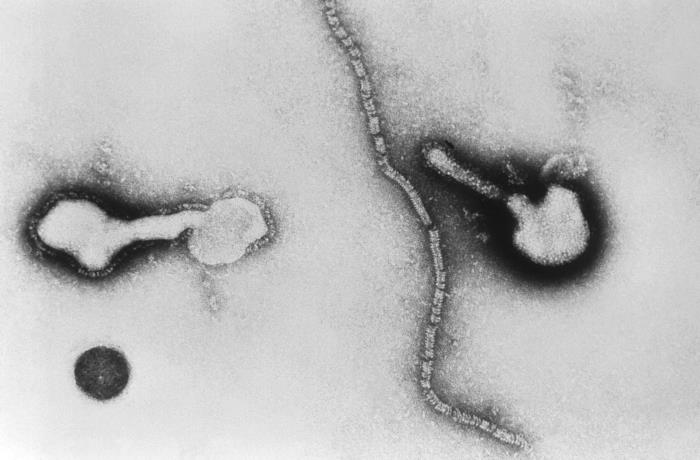Human parainfluenza virus: Difference between revisions
Jump to navigation
Jump to search
No edit summary |
No edit summary |
||
| Line 62: | Line 62: | ||
==Transmission== | ==Transmission== | ||
*Human parainfluenza virus is primarily transmitted by the following:<ref name="urlHuman Parainfluenza Viruses | Transmission of HPIVs | CDC">{{cite web |url=http://www.cdc.gov/parainfluenza/about/transmission.html |title=Human Parainfluenza Viruses | Transmission of HPIVs | CDC |format= |work= |accessdate=}}</ref> | *Human parainfluenza virus is primarily transmitted by the following:<ref name="urlHuman Parainfluenza Viruses | Transmission of HPIVs | CDC">{{cite web |url=http://www.cdc.gov/parainfluenza/about/transmission.html |title=Human Parainfluenza Viruses | Transmission of HPIVs | CDC |format= |work= |accessdate=}}</ref> | ||
**Airborne respiratory droplets from coughing and sneezing | **Airborne respiratory droplets from [[cough|coughing]] and [[sneeze|sneezing]] | ||
**Close physical contact with an infected individual | **Close physical contact with an infected individual | ||
**Physical contact with a contaminated surface | **Physical contact with a contaminated surface | ||
Revision as of 18:15, 27 January 2016
|
Croup Microchapters |
|
Diagnosis |
|---|
|
Treatment |
|
Case Studies |
|
Human parainfluenza virus On the Web |
|
American Roentgen Ray Society Images of Human parainfluenza virus |
|
Risk calculators and risk factors for Human parainfluenza virus |
| Human parainfluenza virus | ||||||
|---|---|---|---|---|---|---|
 A Transmission Electron Micrograph (TEM) depicting parainfluenza virions, and free filamentous nucleocapsid material.
| ||||||
| Virus classification | ||||||
|
This page is about microbiologic aspects of the organism(s). For clinical aspects of the disease, see Croup.
Editor-In-Chief: C. Michael Gibson, M.S., M.D. [1] Associate Editor(s)-in-Chief: Luke Rusowicz-Orazem, B.S.
Overview
Microbiological Characteristics
- The human parainfluenza virus genome consists of approximately 15,000 nucleotides used to encode the following six structural proteins:.[3]
| Protein | Location | Function |
|---|---|---|
| hemagglutinin | Envelope | Attachment and cell entry |
| fusion protein | Envelope | Fusion and cell entry |
| matrix protein | Within the envelope | Assembly |
| nucleoprotein | Nucleocapsid | Forms a complex with the RNA genome |
| phosphoprotein | Nucleocapsid | Forms as a part of the RNA polymerase complex |
| large protein | Nucleocapsid | Forms as a part of the RNA polymerase complex |
- Human parainfluenza virus is a member of the paramyxoviridae family.
- The genus for human parainfluenza virus depends on its serotype:[3]
- Respirovirus: HPIV-1 & HPIV-3
- Rubulavirus: HPIV-2 & HPIV-4
Transmission
- Human parainfluenza virus is primarily transmitted by the following:[4]
Virology
- Human parainfluenza virus infiltrates histiocytes, lymphocytes, plasma cells, and neutrophils white blood cells.[5].
- HPIV fuses with the white blood cells through the glycoproteins hemagglutinin-neuraminidase and fusion protein.[3]
- Upon fusion, the HPIV nucleocapsid is expelled into the recipient cell cytoplasm.[3]
- Viral transcription occurs through virus-specific RNA-dependent RNA polymerase.[3]
- The viral mRNAs are translated into viral proteins, leading to the replication of the genome into the following:[3]
- Positive-sense RNA strand
- Negative-sense RNA strand
- The negative-sense RNA strand is encapsidated by nucleoprotein and is then used for further transcription and replication.
References
- ↑ Vainionpää R, Hyypiä T (1994). "Biology of parainfluenza viruses". Clin. Microbiol. Rev. 7 (2): 265–75. PMC 358320. PMID 8055470.
- ↑ Baron, Samuel (1996). Medical microbiology. Galveston, Tex: University of Texas Medical Branch at Galveston. ISBN 0-9631172-1-1.
- ↑ 3.0 3.1 3.2 3.3 3.4 3.5 Henrickson, K. J. (2003). "Parainfluenza Viruses". Clinical Microbiology Reviews. 16 (2): 242–264. doi:10.1128/CMR.16.2.242-264.2003. ISSN 0893-8512.
- ↑ "Human Parainfluenza Viruses | Transmission of HPIVs | CDC".
- ↑ Cherry, James D. (2008). "Croup". New England Journal of Medicine. 358 (4): 384–391. doi:10.1056/NEJMcp072022. ISSN 0028-4793.